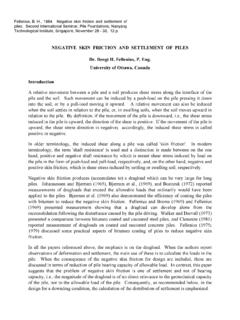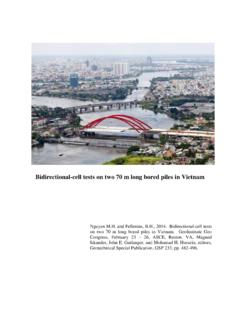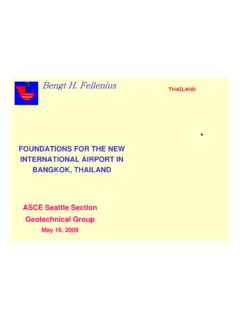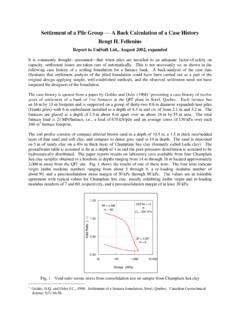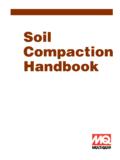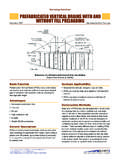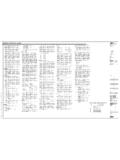Transcription of 339. Massarsch, K.R and Fellenius, B.H., 2014. Part 1 ...
1 339. Massarsch, and Fellenius, , 2014. Ground vibrations from pile and sheet pile driving. Part 1 Building Damage. Proceedings of the DFI-EFFC International Conference on Piling and deep Foundations, Stockholm, May 21-23, pp. 131-138. 131 GROUND VIBRATIONS FROM PILE AND SHEET PILE DRIVING Part 1 BUILDING DAMAGE K. Rainer Massarsch, Geo Risk & Vibration AB, Bromma, Sweden, Bengt H. Fellenius, 2475 Rothesay Ave., Sidney, BC, Canada, Abstract Vibrations generated during the driving of piles or sheet piles can affect buildings or installations in the ground. However, observed building damage is not always caused directly by dynamic effects, but can also be related to foundation conditions. The importance of geotechnical conditions is usually not taken into consideration in most vibration standards. This paper describes how building foundations, and in particular mixed foundation types, are especially sensitive to ground vibrations.
2 A method is presented for assessing the risk of settlement due to vibrations in granular soils. Also, a simple concept is proposed for estimating settlements in the vicinity of driven piles. 1. INTRODUCTION Under unfavorable conditions, the installation of piles or sheet piles can cause damage to buildings or other structures on the ground. Frequently, such damage is attributed to vibrations of the building itself. In many countries, national or international standards are used to assess the risk of vibration damage to buildings. As such standards are often prepared by engineers with little or no geotechnical knowledge, the effects of ground conditions on vibration propagation and damage to building foundations are generally not recognized, and damage criteria based solely on the dynamic response of buildings neglect the importance of damage mechanisms governed by geotechnical conditions.
3 One potentially important damage mechanism is differential settlement below buildings, especially when these are founded on loose granular soils. When seeking guidance in the literature, little or no information can be found regarding methods to assess permissible levels of ground vibrations with respect to risk for settlement. This paper focuses on building damage that can be attributed to foundation conditions. In the case of ground vibrations due to pile and sheet pile driving, differential settlements are of particular importance as the ground vibrations attenuate relatively rapidly from the source. Consequently, settlement below part of the building, which is located close to the vibration source, can be significantly larger than at a distance further away. Piles are often a cost-effective foundation solution for buildings on loose and compressible soil, frequently located in urbanized areas.
4 Sheet piles are commonly used as support for deep excavations. While impact driving is most commonly used to install piles, vibrators are frequently used for driving (and extraction) of sheet piles. It is important to recognize the fundamental differences between impact and vibratory driving. During impact driving, the pile is subjected to stress waves of short duration. The driving process creates vibrations, which radiate from the shaft and/or the toe of the pile into the soil. The larger the intensity of the stress wave, the larger the dynamic force and the intensity of ground vibrations. In addition to the vibration intensity, which often is expressed in terms of particle velocity, also the vibration frequency is important. When the dominant frequencies of the generated vibrations harmonize with the resonance frequency of buildings or building elements, the risk of building damage increases.
5 In the case of impact pile driving, the frequency content of ground vibrations cannot be controlled by changing the pile driving process. In contrast, during vibratory driving, the pile or sheet pile is rigidly attached to the vibrator, which oscillates vertically at a frequency, which can be chosen and modified by the operator. The operating frequency and amplitude of modern vibrators can be adjusted in order to achieve optimal driving while minimizing environmental impact. However, if a vibrator is operated at or near the resonance frequency of buildings or building elements, strong vibrations can be 132 generated. This effect can be used to increase the efficiency of deep vibratory compaction systems, such as resonance compaction (Massarsch and Fellenius, 2005). When a pile penetrates easily into the ground, the intensity of transmitted vibrations will be low. However, vibrations increase when denser soil layers are encountered and pile penetration speed decreases.
6 Ground vibrations depend thus on the geotechnical conditions which need to be considered in the risk assessment. During the initial phase of pile penetration, the source of vibrations will be located close to the ground surface. However, when the pile penetrates deeper into the ground, the source of vibrations becomes more complex. Vibrations can be emitted from the toe of the pile but also along the pile shaft. Therefore, geotechnical conditions are of great importance when trying to predict the intensity of ground vibrations. It is important that the location is known of stiff soil layers, through which the pile shall be driven and which can give rise to strong ground vibrations. An in-depth discussion of factors influencing ground vibrations due to pile driving was given by Massarsch and Fellenius (2008). 2. RISK OF BUILDING DAMAGE DUE TO VIBRATIONS In assessing the risk for damage to a building due to pile-driving induced vibrations, it is important to make clear define the type of building damage that is considered.
7 Moreover, one must also realize that the damage can occur as a secondary effect of the vibration, that is, it can result from settlement of the soil on which the building is resting. Damage Categories Damage can occur to buildings in connection with construction activities. Although noise and vibrations caused by pile and sheet pile installation can be experienced by humans as annoying or disturbing, these do not necessarily cause damage. Damage to buildings and their foundations can be related to different mechanisms. In Figure 1, four different damage categories are shown. Damage Category (I) comprises static ground movements, which can occur for instance in the vicinity of deep excavations. The installation of displacement piles can also give rise to heave and lateral displacements, which can damage buildings. Another possible source of static soil movement can be from the vibration-triggered movement of adjacent slopes or excavations with low factor of safety.
8 Damage to buildings caused by ground distortion belongs to Damage Category (II). When the waves propagate along the ground surface, foundations of adjacent buildings can be subjected to a large number of upward (hogging) and downward (sagging) movements. The risk of damage is then largest when the length of the building corresponds to approximately half the wave length. Massarsch and Broms (1991) described how damage to buildings or installations can be analyzed when subjected to ground distortion. Damage to buildings due to settlement caused by ground vibrations belong to Damage Category (III). Settlement due to vibrations is largest in loose, granular soils, such as sand and silt. In the case of pile driving, differential settlements are more critical than total settlement. This topic is the main subject of this paper. Damage Category (IV) comprises building damage caused by dynamic effects in the building itself and is the only damage category, which is normally considered in vibration standards.
9 Influence of Building Foundation Ground conditions play an important role when assessing the risk of damage due to pile-driving induce vibrations. Figure 2 illustrates three examples with larger than normal risk for damage to buildings. The first example (a) is a building on loose sand or silt. If the building is founded on uncompacted granular soil and the area has not previously been exposed to strong ground vibrations, the building is more prone to suffer vibration damage. When piles or sheet piles are driven at a distance of approximately less than one pile length, the risk of differential settlement damage can be significant, especially when piles are driven through a stiff surface layer. This is due to the fact that vibrations will be largest close to the source but attenuate quickly, thereby increasing the risk of differential settlement.
10 However, when the vibration source is located at larger depth, vibrations at the ground surface will vary less at the ground surface and the risk of differential settlement is lower. 133 Figure 1 Possible damage mechanisms due to driving of piles or sheet piles, (Massarsch, 2000). The second case (b) shows a building, which is founded in a slope, where material had been excavated from the slope and placed to create a level foundation. Unless the placed fill is well-compacted, the risk of differential settlement between the fill and the excavated area below the building will be high. The third example (c) shows a building, which is partly founded, on natural or filled soil, and partly on piles. Differences in stiffness of the foundation can lead to differential movements between different parts of the building. 3. SETTLEMENT IN GRANULAR SOIL DUE TO GROUND VIBRATION While most vibration standards address the effects of ground vibrations on buildings, few recognize the potential risk of building damage that can be caused by settlement in the ground below a building foundation.



